Best Ohio Steelhead Rivers: Access Maps And Best Methods
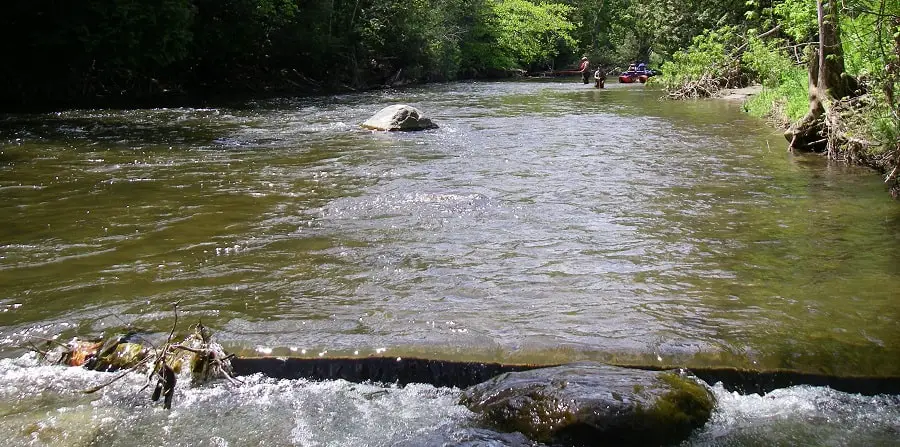
I have had the opportunity to fish all the best Ohio steelhead rivers over the last 25 years.
The best steelhead rivers in Ohio are the Chagrin River, Grand River, Conneaut Creek, Vermilion River, and Rocky River. These five steelhead rivers have the biggest runs of steelhead and have enough access that anglers can actually fish and explore them.
If you are looking for all the best methods, best flies, best baits, and maps for accessing and fishing steelhead in Ohio, you are in the right place.
8 Best Ohio Steelhead Rivers
Ohio contains some of the best and most rewarding steelhead tributary rivers in the Great Lakes region. Anglers who know these rivers well and know how to fish for the steelhead in them, report an average of twelve steelhead a day during the peak times.
All the rivers fish the same with the same lures, baits, flies, and methods, which I discuss in more detail below.
Chagrin River
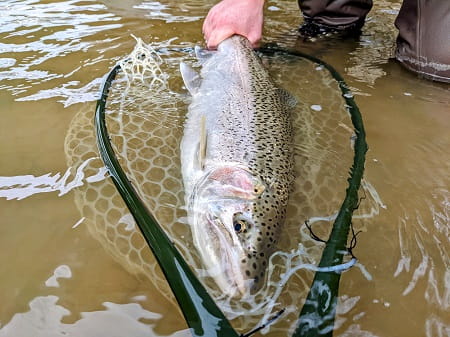
The Chagrin River is located in Northeast Ohio. It is medium-sized and features a moderate gradient, thus making it easy for anglers to walk through.
Local steelhead anglers consider the Chagrin River one of the best Ohio steelhead rivers because it has large steelhead runs and good access.
Alley Grabs Guide Service provides many guided trips to this river and teaches anglers the best fly fishing methods for this river.
This Ohio steelhead river runs through Cleveland‘s suburban areas and empties into Lake Erie, flowing through Cleveland’s Metropark area, but there is plenty of great scenery and wooded areas, making it look like you are far from civilization.
The Chagrin River is one of the primary rivers for steelhead stocking by the Ohio DNR, and it consists of two tributaries that have runs of steelhead. This stocking of this river is why possibly tens of steelheads of steelhead come back to spawn.
The steelhead fishing strategies common to this river are Nymphing with a single-hand fly rod and an indicator, Euro Nymphing, switch rod and Spey casting, spin fishing with lures or bait, and float fishing with a spinning reel or Centerpin reels.
Nymphing with a fly rod is often the most effective way to catch steelhead on any Ohio steelhead river, and I discuss the tactics and flies used by pro guides on my page Nymphing For Steelhead: The 3 Most Effective Methods.
Anglers that know how to do these methods well will be more successful. If you want tips on all the best methods for catching steelhead, check out my page, Steelhead Fishing – Most Effective Methods For Steelhead
Best Time to Fish:
The Chagrin River has an average run-off time of between three to four days and is best fished when the stream flow is between 150 and 350 cfs. (cubic feet per second)
Access Points to Chagrin River:
The Chagrin River is surrounded by long stretches of private water, however, there are some great access spots including, the Lake Metroparks and the Cleveland Parks provide the best public access.
You can see a great map of nine access spots for anglers to fish for steelhead at Chagrin Fishing Acess Map.
See more at Chagrin River Steelhead Fishing.
Grand River Ohio
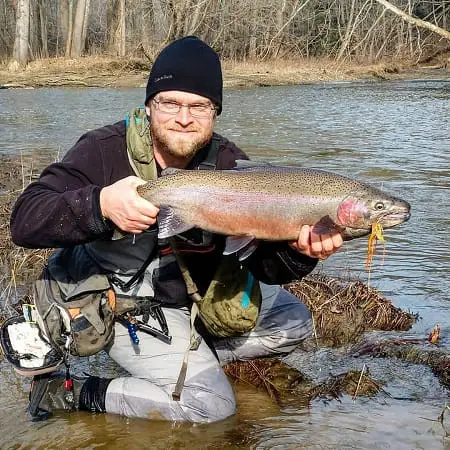
The Grand River is a stunning large-sized tributary to Lake Erie with a shale-bottom and fishable water of about 100 miles, beginning from southeastern Geauga County to Lake Erie, Ohio.
The Grand River is the largest Lake Erie steelhead tributary in Ohio.
This is another river that many guides like Gareth from Alley Grabs Guide service like to fish on and guide.
The Grand River is big enough to find unpressured water and can be guided or fishing by foot or boat.
Grand River is also one of five Lake Erie tributaries that are stocked by the Ohio DNR with Little Manistee River steelhead annually, which return to the river each year.
Best Time to Fish:
The Grand River gets runs of steelhead starting around late September, with peak runs in November. The Grand River has steelhead in the river all winter and then has another peak steelhead time in March. Some steelhead can even be caught in early May.
The Grand River has an average run-off time of between 1-2 weeks after it floods from large rains or snowmelt. This implies that this Ohio steelhead river takes the longest time to get back to normal flow level following big rain events. The Grand River is best fished for steelhead when the streamflow is between 250-450 CFS.
Access Points to Grand River:
The Grand River boasts a number of good access points for river anglers and some access and pull-out points for boaters – pull-outs are for pulling river boats and rafts out of the water.
Fishing with boats is a great way to see the river and get to spots other anglers can’t. The use of boats has allowed me and my clients to catch thousands more trout and steelhead. I discuss the best river boats and tips and advice on how I use them to even get into private waters on my page Fly Fishing Boats: Catch More Fish With A Boat.
For anglers on foot, there are plenty of access spots along the Grand River. Check out this excellent fishing access map – Grand River Fishing Access Map
Best Baits for the Grand River Steelhead
Effective baits for catching steelhead in the Grand River are the same as above for the Chagrin River.
Cuyahoga River
Cuyahoga River is another large-sized steelhead river in Ohio with primarily a shale bottom.
This is one steelhead river with an interesting history of pollution and fire eruption, which led to its alternative name – the burning river or river that caught fire.
The Cuyahoga River flows for as long as 100 miles, through the cities of Cleveland and Akron before it finally empties into Lake Erie.
It is one of the tributaries of Lake Erie that does not receive stockings by the Ohio DNR, but still gets a good spring run of Little Manistee steelhead. Some steelhead also enter this river in the fall and in the winter under high water conditions.
Best Time to Fish
Similar to the Grand River, the Cuyahoga River is a bigger river and it takes an average of one week for the Cuyahoga River to get back to normal flow levels following big rain events. The Cuyahoga River is best fished when the streamflow is between 250-350 CFS.
Access Points to the Cuyahoga River
According to the map of designated steelhead fishing areas, as published by the Ohio DNR, anglers can find public access points at Brecksville (the Rt. 82 Dam) and Cleveland Metroparks (Gorge Park). Cuyahoga River Fishing Access Map.
Best Baits for the Cuyahoga River
Effective flies, baits, and lures for catching steelhead in the Cuyahoga River are the same as listed for the above rivers.
Rocky River
The Rocky River is a mid-sized shallow tributary of Lake Erie and one of the best steelhead rivers in Ohio. Its bottom consists of shale, silt, mud, and rock.
It is also on the list of Lake Erie tributaries that are stocked annually with Manistee strain steelhead by the ODNR.
The Rocky River receives runs of steelhead from September through May.
This river is a popular destination for steelhead anglers due to its proximity to the Eastern and Western suburbs of Cleveland.
Best Time to Fish:
The water level of this river after a heavy rain is known to rise and fall fast. It is best fished when its water level has reached its high point and begins to fall, which is when it starts to clear enough to fish. The river at this point should be averaging about 300 CFS.
Access Points to Rocky River:
According to the Ohio DNR map, there are over 13 access points to this river, including the Cleveland Metroparks.
Best Bait for Rocky River:
Effective baits, flies, and lures for catching steelhead in the Rocky River are the same as the rivers listed above.
For more information, check out my page, Steelhead Fishing On the Rocky River.
Ashtabula River
The Ashtabula River is a medium-sized steelhead river with shale-bottom and is one of the best steelhead rivers in Ohio.
It is located northeast of Cleveland in Ohio and empties into Lake Erie at the city of Ashtabula, Ohio. The Ashtabula River provides a quiet spot for steelhead fishing within a large cities outer limits.
The Ashtabula River is 40 miles long with a draining capacity of 137 square miles. The river is believed to house some of the largest steelhead trout in the state, and it receives a spring run of Little Manistee steelhead. This makes it a prime destination for steelhead anglers.
Best Time to Fish
The Ashtabula River does not have a water gauge on it, so the water levels can’t be measured. As one of the smallest steelhead rivers, it clears before most other tributaries, making it a good option to fish when other steelhead rivers are too high and too muddy to catch steelhead.
Access Points To Ashtabula River
The Ashtabula River has quite a number of access points. Some of them include Stanhope Kelloggsville Road bridge, Plymouth Ridge Road. bridge, Indian Trails Park, and Haddock Road.
Best Baits for the Ashtabula River
Effective baits, flies, and lures for catching steelhead in the Ashtabula River are the same as the other Ohio rivers listed above.
Watch Bill Spicer from the New Fly Fishing TV Show, fishing with Jeff Blood on the Ashtabula River. Spring Steelhead Ohio Video
For more detailed information on Steelhead fishing on the Ashtabula River, check out my page, Ashtabula River Steelhead Fishing.
Conneaut Creek
Conneaut Creek is a medium-sized steelhead river tucked away in the far northeastern corner of Ohio. It runs from Conneautville, Pennsylvania, down 30 miles, during which it enters Ohio before making its way into Lake Erie.
This Creek is stocked from both Ohio and Pennsylvania. Its bottom consists primarily of gravel, silt, cobble, shale, and sand.
Steelheads generally find their way into the Conneaut Creek in late October and begin to find their way out of the river towards the end of April.
Best Time to Fish:
Conneaut Creek is best fished when the stream flow is between 150-350 cfs, and the best fishing methods employed here are nymph fishing, wet fly swing, lure fishing, and float fishing with either a spinning reel or with a Centerpin reel.
Access Points to Conneaut Creek:
There are several access points to Conneaut Creek in Ohio, but are mostly around private properties such as woodlands and farmlands. It can be publicly accessed through Lakeville Park Access off Center Road and Conneaut Harbor.
Best Bait for Conneaut Creek:
Effective baits, flies, and lures for catching steelhead in Conneaut Creek are the same as the rives above.
Vermilion River
The Vermilion River is another medium-sized tributary of Lake Erie and is located in northern Ohio. Its watershed runs through five counties in parts – Richland, Lorain, Ashland, Erie, and Huron, and finally empties into the Central Basin of Lake Erie’s in the city of Vermilion.
Vermilion River enjoys generous stocking efforts from the Ohio Division of Wildlife annually, which is responsible for the excellent returns of spring-run steelhead. The name Vermilion is derived from the predominant reddish clay soil along the route of the river, which makes it muddy after any rain event.
Best Time to Fish:
Vermilion River has an average run-off time of about four days. Its spring run begins in November and lasts till April or May. During this time, the river is best fished when the stream flow is between 100-250 cfs.
Access Points to Vermilion River:
The Vermillion River has a number of access points – both privately and publicly owned. Public access points include Rambling River Park, Metro Parks, Miles Parcel, and Otting off the Vermillion River A.M.A.
Best Baits for Vermilion River:
Effective baits, flies, and lures for catching steelhead in the Vermilion River are the same as the rivers mentioned above.
Arcola Creek
Arcola Creek is located near Ashtabula, about 2.8 miles from Geneva-on-the-Lake, in Lake County, northeast Ohio. This stream goes by several other names, such as Cunninghams Creek, Arcole Creek, and Big Creek.
Even though Arcola Creek does not enjoy stockings by the Ohio DNR, it still receives a spring run of stray Manistee steelhead every year. It is also possible to catch some steelhead through the fall and winter on this river.
Best Time to Fish
Similar to the Ashtabula River, Arcola Creek has no information on its water level measurement.
It is best to fish for steelhead on this river one to three days after larger rains raise the river’s levels. If you arrive and the river is muddy, it’s best to go to one of the other nearby steelhead rivers that drop and clear faster.
Access Points the Arcola Creek
The primary access points to this stream available to the public are the Lake Metropark and beach.
Best Baits for the Arcola Creek
Effective baits, lures, and flies for catching steelhead in Arcola Creek are the same as the above rivers.
Best Baits, Lures, And Flies for Ohio Rivers:
Effective baits for catching steelhead in the Chagrin River and most other Ohio Rivers include the following:
- Basic egg flies – such as the Glo Bug, Blood dot fly, or Estez egg. In fall, I like sizes 10 to 14, depending on the water color, and in the spring, when the water is low and clear, a size 12 or 14 can be the best option.
- Nymph flies such as the Pheasant tail nymphs and the Stonefly nymphs are great. Depending on water clarity and time of year, I will use sizes 8 to 12.
- Streamer patterns like the wooly bugger and egg-sucking leech in sizes 6 to 10 are good options. I like black, olive, green, and white, and the water color will often dictate which color or size the fish want.
When it comes to fly fish, we asked the experts at Alley Grabs Guide Service in Ohio and they said, “Soft, subtle-colored egg patterns and small Clouser minnows work well. Black or amber stoneflies are also good in springtime when the fish have been in a while or after the spawn. Eggs should be small – 7mm in diameter.”
You can see some of the most effective steelhead fly patterns that I use when guiding on my page 19 Most Effective Steelhead Flies.
If you are interested in learning how to fly fish for steelhead and want to know the methods that guides use, check out my page, Fly Fishing Great Lakes steelhead.
The best baits for spin and float fishermen include:
- Egg Sacks – Colors pink, peach, orange, and chartreuse. I change colors and sizes based on conditions.
- Worms – Pink, brown, and red 3-inch plastic worms can be deadly effective.
- Jigs – Steelhead jigs can be very effective. See my page Steelhead Jigs: The 11 Best Steelhead Jigs And How To Fish Them
- Trout Beads – not such a secret anymore, but a very effective bait. See my page Fishing With Beads: 5 Guide Tips For More Fish
- Flies – Flies can be used under a float, when bottom bouncing, or with drift fishing and with a fly rod.
We know that not everyone likes to fly fish, so for all the best steelhead baits that I use and that other guides use, check out my very popular page, Best Baits For Steelhead.
All of these can be fished with lures, and generally, the same lures that work on other Great Lakes steelhead rivers will work in Ohio streams. Lures like spinners, spoons, crankbaits, and jigs are good options.
For info on my most productive lures and tips on how to fish them, check out my page, Best Lures For Steelhead – A Pro Guides Recommendations.
Float fishing for steelhead is arguably the most effective way to catch steelhead around the Great Lakes region, but bottom bouncing is better in shallow runs and pools and in pocket water. Plunking is a good still-water bait fishing method used at the river mouths.
If you are a float fisherman and want my guide tips and advice on float fishing with a spinning reel or with Centerpin reels and rods, check out my page, Float Fishing For Steelhead.
All the rivers listed below are best fished with the above baits and flies.
Other Steelhead Rivers In Ohio
Other Steelhead streams in Ohio I would recommend are Beaver Creek, Turkey Creek, Black River, and Cold Creek.
These rivers also have large runs of steelhead and access that anglers can actually fish from.
More information on how to get started with steelhead fishing – licensing requirements and regulations are available on the Ohio Department of Natural Resources official website.
Also, before you plan a trip to any rivers (especially for those not sure where to go), another good place to start is the Ohio DNR Steelhead Rivers Fishing Maps. This resource gives you more information on public access points and directions to the best fishing spots.
Tight Lines,
Graham

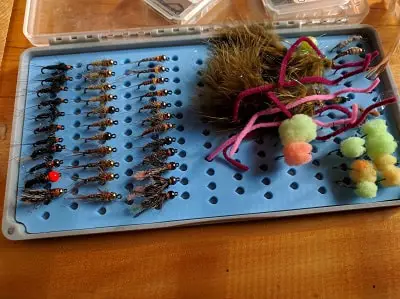
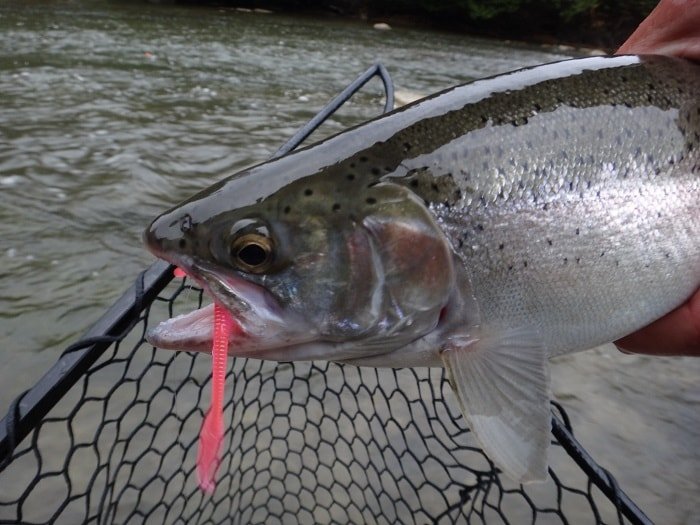
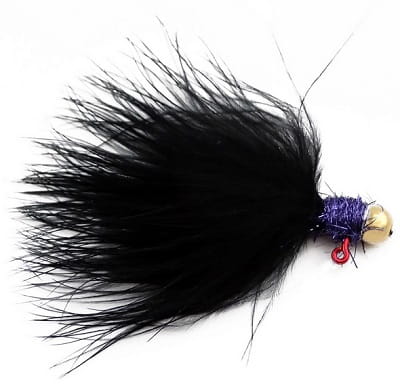
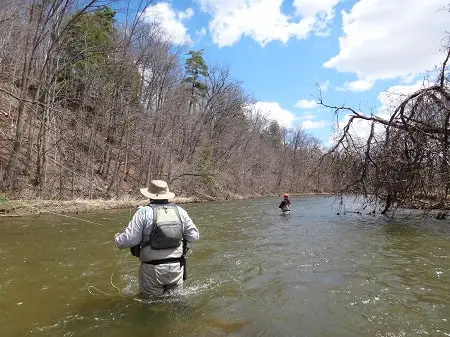
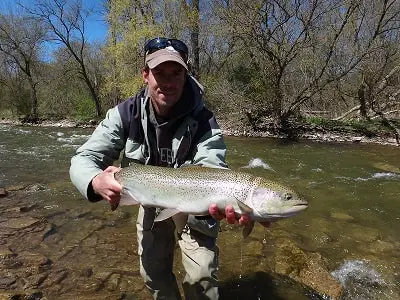
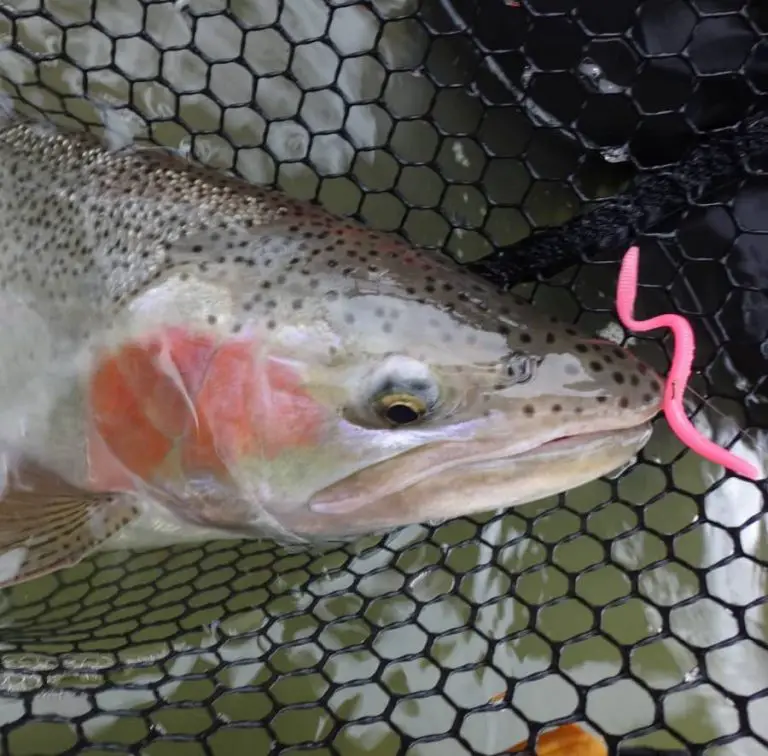
Which of these streams see the lightest fishing pressure?I like solitude when I fish.
Hi Greg,
The problem with telling you what river has the lightest pressure on a public website is that everyone might go there and then it won’t have the lightest pressure anymore, and it will probably make the anglers of that river angry. Therefore I would suggest doing a little exploring on your own. During peak run times a simple drive to each access point will tell you if it’s a busy river or a busy spot just by how many cars are there.
Sorry I could not be more help.